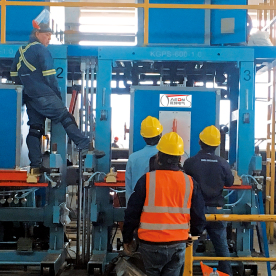In today’s fast-paced manufacturing environment, the need for efficiency, precision, and durability is more crucial than ever. One of the key technologies that has risen to meet these demands is the high-frequency welder machine. This advanced piece of equipment utilizes high-frequency electrical currents to produce quick and reliable welds, significantly improving the productivity of industries ranging from automotive to textiles. In this article, we will explore the various benefits and applications of high-frequency welder machines, highlighting their importance in modern manufacturing.

Understanding the Benefits and Applications of High Frequency Welder Machines in Modern Manufacturing
High-frequency welding employs a process known as dielectric heating, where high-frequency electromagnetic fields generate heat within the materials being welded. This technique allows for the bonding of different types of materials, including thermoplastics, rubber, and even some thin metals. The result is a strong seam that can withstand significant stress and strain, making it ideal for heavy-duty applications. One of the standout advantages of high-frequency welding is its ability to weld materials with differing thicknesses without the need for additional filler materials or intricate setups.
One of the primary benefits of high-frequency welder machines is their speed. Traditional welding methods can be time-consuming, often requiring lengthy setup and cooldown periods. In contrast, high-frequency welding allows for rapid production cycles, enabling manufacturers to boost output and meet increasing market demands. This efficiency not only reduces operational costs but also allows businesses to remain competitive in a landscape where time-to-market is vital.
Moreover, high-frequency welding delivers consistent and uniform welds, which is essential in maintaining quality standards. The precision of this welding technique minimizes the risk of defects and ensures that products meet stringent safety and performance criteria. Manufacturers can rely on high-frequency welder machines to produce high-quality joints that are resistant to environmental factors, mechanical stress, and fatigue.

Understanding the Benefits and Applications of High Frequency Welder Machines in Modern Manufacturing
The versatility of high-frequency welding makes it suitable for a multitude of applications across various industries. In the automotive sector, for example, high-frequency welders are utilized to create components such as fuel tanks, bumpers, and interior trims. The ability to weld different materials together, including plastics, enhances the design and functionality of automotive parts, contributing to the overall efficiency of vehicle production.
In the textile industry, high-frequency welding is employed to seal seams and create waterproof barriers in products like rain gear, tents, and outdoor equipment. The need for durable and lightweight materials has made high-frequency welder machines increasingly popular, as they allow for the manufacture of products that can withstand adverse weather conditions while remaining easy to carry and use.
Another important application of high-frequency welding is in the production of medical devices. With strict regulatory standards in place, the medical industry demands high precision and reliability in its manufacturing processes. High-frequency welds are ideal for creating complex shapes and designs in medical tubing, bags, and other products where sterility and strength are paramount.
Despite their many advantages, high-frequency welder machines do come with some considerations. For starters, the initial investment in high-frequency welding equipment can be significant. However, businesses often find that the long-term savings in labor, material waste, and production efficiency justify the upfront cost. Additionally, operators need specialized training to handle this type of equipment effectively and safely, emphasizing the importance of investing in staff education and training.

Understanding the Benefits and Applications of High Frequency Welder Machines in Modern Manufacturing
Furthermore, while high-frequency welding is a flexible and efficient method for many applications, it may not be suitable for all types of materials. Understanding the specific requirements of each project is essential to determine whether high-frequency welding is the right choice or if an alternative method, such as traditional welding, would be more effective.
In conclusion, high-frequency welder machines are transforming the manufacturing landscape by providing rapid and reliable welding solutions. With their wide range of applications across various industries, from automotive to medical, and their ability to produce consistent, high-quality welds, these machines are an invaluable asset for modern manufacturers. As technology continues to advance, the role of high-frequency welding in meeting the demands of quality and efficiency will likely grow even more critical, solidifying its place in the future of manufacturing.Customized ERW tube mill solutions



